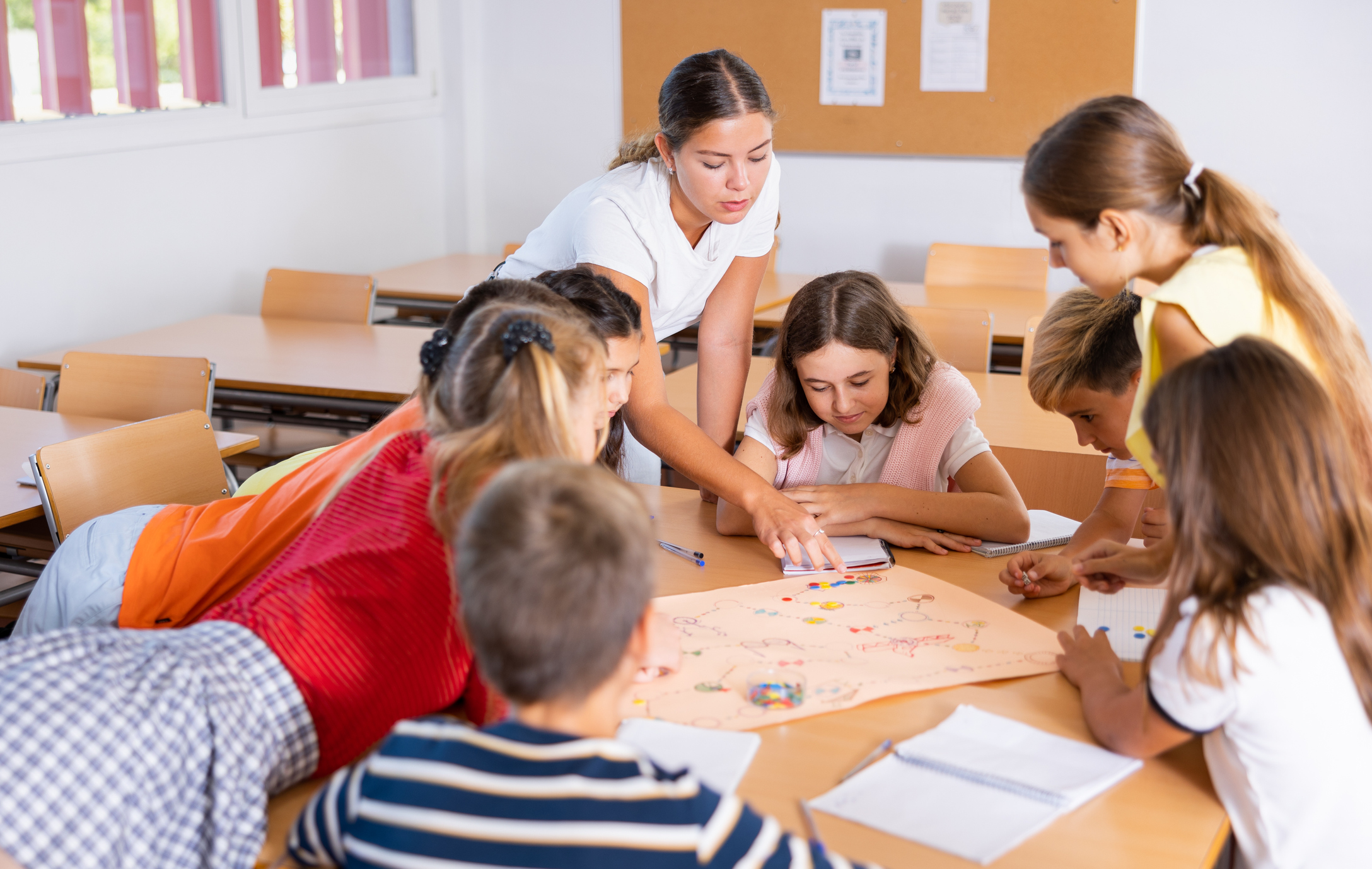Alex Cohill is a special education teacher with ten years of experience serving students with severe cognitive disabilities and specializing in phonics instruction, assessment tracking, and functional learning.
Here, Alex dives into the benefits of play-based learning for all learners, not just in early education, and shares strategies and ideas for providing play experiences and creating play-based learning environments.

We typically associate “play” with early childhood education. Images of finger painting, building blocks, and dress-up come to mind. However, when considering its core components, “play” has cognitive, social, and emotional benefits that extend far beyond early learning. While play looks different across ages, integrating playful learning deepens understanding and engagement at all levels. Like an experiment, play involves trial and error, taking risks, and learning from mistakes. By recasting lessons through a playful lens, teachers empower students to engage in learning while mastering material in a creative context.
Play-Based Learning for Older Students
“Play” takes on varying definitions throughout child development. In 2015, Michigan State University researchers expanded upon Mildred Parten’s iconic 1929 research paper outlining the 6 stages of play1. The MSU research delineates stages spanning infancy through adolescence. While toddler play entails sensory exploration, preschooler play uses imagination and role-playing. Play grows more rule-based and structured in elementary school, blossoming into strategy and problem-solving in middle school.
By high school, play manifests as experimentation and improvisation. Teens play with complex concepts, test hypotheses, and make interdisciplinary connections. College students play through debates, design challenges, and simulated scenarios. Though the methods change, the joy of discovery remains.
At its core, play is self-motivated, hands-on, and centered on process over product. Play energizes learning by sparking curiosity over rote memorization. It empowers students to explore while teachers provide guardrails and guidance.
The Science Behind Play
These decades of research highlight the benefits of play for cognitive development and building social and emotional skills. Play activates the brain’s reward circuitry (AKA dopamine output,) helping children manage stress and regulate emotions. Physical play boosts motor skills and body awareness. Socio-dramatic play builds perspective-taking, empathy, and conflict resolution. As kids play, they create mental models of the world while practicing problem-solving.
Studies focused specifically on adolescents also reveal advantages. A 2020 systematic review of gamification found play boosts motivation, collaboration, and critical thinking in middle school2. Meanwhile, college students who engaged in guided play activities showed greater focus, engagement, and class contributions when compared to direct instruction.
Neuroscience sheds light on why play-based learning is powerful. Play promotes cognitive elasticity, helping brains form new neural pathways. It also activates the prefrontal cortex associated with executive functioning. Through play, students engage with content in a state of relaxed alertness ideal for encoding new information. While play looks different across ages, the brain-based benefits remain.
Play as Experimentation
Reframing lessons through a playful lens offers many rewards. Play shares similarities with the scientific process of experimentation: identifying a problem, making a hypothesis, testing solutions, observing results, and drawing conclusions. This frames mistakes not as failures, but as opportunities for growth.
Students playfully tinkering with concepts, approaches, and interpretations become free to poke holes, break things, and fail forward. Thomas Edison embodied this inventive spirit with the tried-and-true story of over 1,000 unsuccessful attempts to invent the lightbulb until he reached his objective. Each “failure” taught him something, leading ultimately to success.
Play-based learning creates space for this growth mindset. Just as scientists learn from experiments that don’t go as hypothesized, students make discoveries through hands-on play sans academic penalties. Play provides a scaffold for safely exploring challenging content and daring to fail. Rather than being reprimanded for mistakes, students are encouraged to reflect on what didn’t work and why. Mistakes become springboards for new insights.
7 Strategies to Spark Playful Learning
While play comes naturally to kids, schools often suppress playful impulses by adolescence. Classes emphasize sitting still, listening, and avoiding mistakes. Yet, educational research and neuroscience make a compelling case to bring play back into learning experiences. Below are strategies to integrate play-based learning using your content.
1. Roleplaying
Simulations and roleplaying allow students to step into another world, from Civil War soldier to marine biologist. Simulating real-world scenarios brings concepts to life. Share guidelines and let students take charge. Costumes and props add flair while you observe learning in action.
2. Problem-Solving
Design challenges present an engaging problem and materials to solve it: inflatable balls, index cards, and masking tape. Frame “failure” as iteration to foster creative risk-taking. Have students document each prototype. Discuss what worked, what didn’t, and next steps.
3. Creative Projects
Creative projects instead of papers let students demonstrate learning through art, film, music, poetry, fiction, or other creative means. Establish connections to standards. Providing choice boosts engagement, develops natural curiosity, and personalizes learning pathways.
4. Competitive Interactive Games
Interactive games leverage friendly competition and reinforce concepts. Adapt vocabulary into a Bingo-style game. Review math formulas through a basketball hoops challenge. Many digital tools exist, but easy DIY options work just as well.
5. Class Debates
Class debates encourage perspective-taking, research, and public speaking skills. Assign teams a position to defend or let students choose their stance. Set norms for respectful discourse that builds on ideas. Talk through arguments afterward.
6. Improvisation
Think drama class warm-ups: “Yes, and…” Have students build on each other’s ideas spontaneously to make unexpected connections. Say a random word. Students respond, affirming with, “Yes, and...” before adding a new word or idea. Repeat rapidly.
7. Reflection
Reflection consolidates learning and allows students to articulate takeaways. What challenged me? What would I do differently? Why does this matter? Build in written or discussion-based reflection.
Final Thoughts
Schools should be laboratories for learning – places where students freely experiment, take risks, and learn through discovery. While play is associated with childhood, its cognitive and social-emotional benefits extend through adolescence and adulthood. Play breeds innovation. Research shows learning through play sticks with students longer and enriches academic and life skills.
Of course, play must align with standards and curriculum. With school days consumed by testing, “play” can seem frivolous. However, with intent and purpose, playing complements rather than distracts from academics. Play motivates students to keep experimenting with content until mastery. Integrating play-based learning teaches students it’s okay to fail, as long as you fail forward.
Sources
1The power of play – Part 1: Stages of play. (2015, October 6). Child & Family Development. https://www.canr.msu.edu/news/the_power_of_play_part_1_stages_of_play
2 Smiderle, R., Rigo, S. J., Marques, L. B., Peçanha de Miranda Coelho, J. A., & Jaques, P. A. (2020, January 9). The impact of gamification on students’ learning, engagement and behavior based on their personality traits. Smart Learning Environments. https://doi.org/10.1186/s40561-019-0098-x
Further Reading










